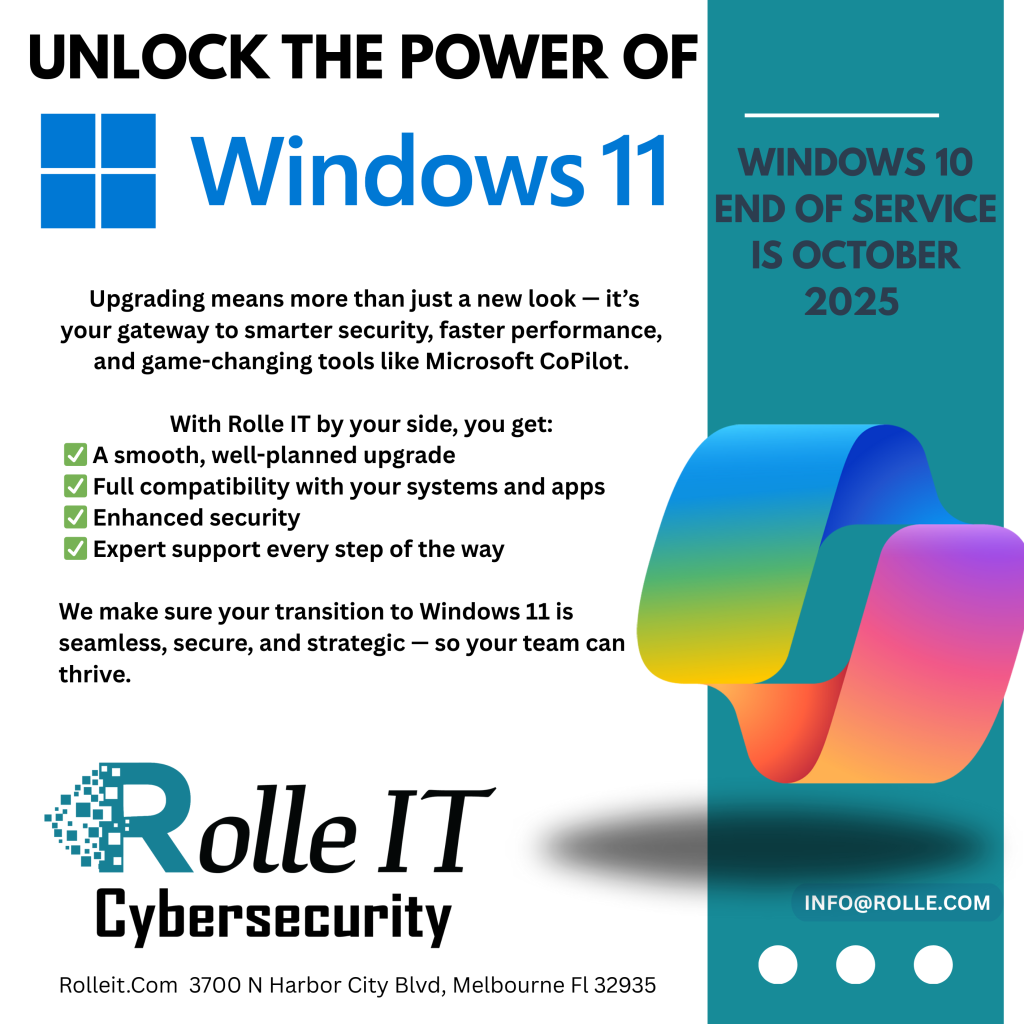End of Support for Windows 10
Upgrading to Windows 11 Is Essential for Modern Businesses
As Microsoft continues to phase out legacy systems, upgrading to Windows 11 is no longer a “nice-to-have” — it’s a business imperative. Whether you’re running critical applications or simply seeking to protect your organization’s digital assets, here are key reasons why making the switch to Windows 11 matters.
🔒 1. Enhanced Security by Design
Windows 11 was built with zero trust security principles at its core. It requires TPM 2.0 (Trusted Platform Module), Secure Boot, and hardware-based isolation to help reduce firmware-level attacks.
According to Microsoft, 60% fewer security incidents were reported on Windows 11 devices compared to Windows 10 in enterprise environments.
Source: Microsoft Security Blog, 2023
⚡ 2. Performance and Efficiency Gains
Windows 11 introduces improvements in memory management, disk usage, and battery efficiency. It’s optimized for hybrid work with features like Snap Layouts, DirectStorage, and better support for virtual desktops.
Windows 11 boots 30% faster and reduces background activity compared to Windows 10, according to Microsoft’s own performance benchmarks.
Source: Microsoft Learn
📆 3. End of Support for Windows 10 Is Coming
Microsoft announced October 14, 2025 as the end of support date for Windows 10. After this, no more security updates or technical support will be available.
Failing to upgrade leaves your systems vulnerable to cyber threats and may result in non-compliance with data protection standards.
Source: Microsoft Lifecycle Policy
🧠 4. AI and CoPilot Readiness
Windows 11 is optimized for AI-driven features, including Microsoft’s CoPilot integration, which enhances productivity, automates tasks, and improves decision-making.
Only Windows 11 supports the next-generation AI experiences baked into Microsoft 365 apps — making it critical for businesses investing in future-forward technologies.
Source: Microsoft Ignite 2023 Keynote
✅ Upgrading with a experienced Firm
Upgrading to Windows 11 isn’t just a technical decision — it’s a strategic move. With better security, performance, and AI capabilities, Windows 11 enables businesses to work smarter, safer, and faster. Windows 11 isn’t just an operating system upgrade — it’s a gateway to enhanced security, better productivity, and future-ready technology. But while the benefits are clear, the path to Windows 11 isn’t always simple. Upgrading without expert support can expose your organization to unnecessary risks, downtime, and compatibility issues.
Let’s explore why upgrading to Windows 11 matters — and why partnering with an experienced IT firm like Rolle IT is critical.
🔧 Upgrading Isn’t Always Plug-and-Play
Despite Windows 11 being built for modern computing, hardware requirements and software compatibility checks make upgrading a challenge for many organizations:
- TPM 2.0, Secure Boot, and a supported CPU are mandatory — disqualifying many older machines.
- Custom or legacy applications may not work reliably, especially in highly regulated or technical industries.
- Licensing and configuration of Group Policies, BitLocker, and endpoint protections must be re-evaluated.
- Upgrades in a hybrid or domain environment (like Azure AD or Active Directory) require careful planning.
A Gartner study found that 40% of organizations faced delays or complications in Windows 11 adoption due to incompatible hardware or legacy systems.
Source: Gartner, 2023
🤝 Why an Experienced IT Firm Matters
A seasoned Managed Services Provider (MSP) like Rolle IT ensures your upgrade is smooth, secure, and tailored to your business environment. Here’s how:
✅ 1. Pre-Deployment Assessment
We evaluate your hardware, applications, licensing, and user needs to determine upgrade readiness and avoid surprises.
✅ 2. Compatibility Planning
We identify applications, drivers, or legacy systems that may need updates or replacements — and implement workarounds where needed.
✅ 3. Staged Rollouts & Downtime Mitigation
Rolling out upgrades in stages reduces business disruption. We provide rollback options, system backups, and contingency planning.
✅ 4. Security Optimization
We ensure TPM, Secure Boot, BitLocker, and Microsoft Defender for Endpoint are configured correctly — not just activated.
✅ 5. Post-Migration Support
From user training on new features like Snap Layouts and CoPilot, to 24/7 helpdesk coverage, we make sure your team stays productive.
According to TechRepublic, “Businesses that partner with MSPs report 65% faster adoption and 30% fewer IT support incidents after a major OS migration.”
Source: TechRepublic, 2023
🏁 Conclusion: Don’t Go It Alone
Upgrading to Windows 11 unlocks a new era of security, performance, and intelligent tools — but the transition must be carefully managed. Choosing a proven IT partner ensures:
- Full compliance with Microsoft’s evolving standards
- Minimal disruption to your business
- Long-term support and optimization

Rolle IT brings years of experience in managing OS transitions across industries. We don’t just upgrade — we future-proof your IT. [email protected]
End of Support for Windows 10 Read More »
